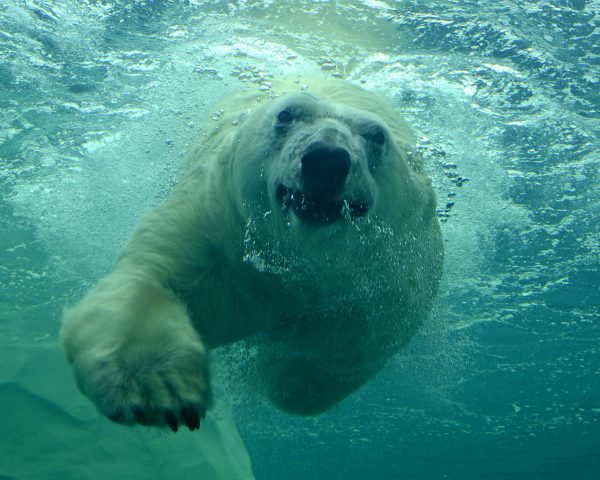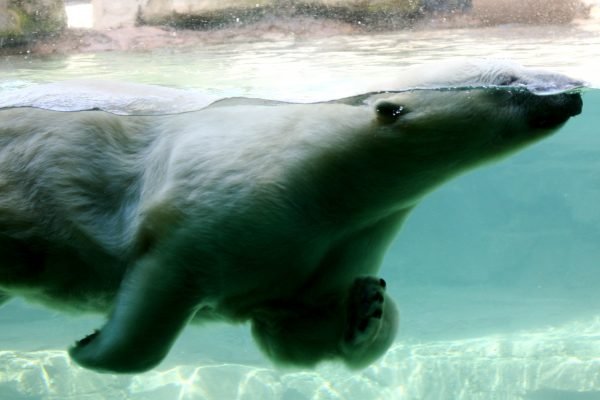Polar bears depend on the arctic ice for catching its prey. But due to global warming sea ice has declined, which has pushed the polar bears to swim longer distances to reach solid ice sheets. Swimming is also one of the arctic adaptations of a polar bear to the harsh arctic climate. Amongst all the bear species, they are known for their outstanding swimming abilities. They are considered as marine animals though they resemble a lot to the land mammals. Polar bears are capable of swimming for hundreds of miles or even for hours to many days. Now let’s explore interesting facts about “How Fast Can a Polar Bear Swim” to have a clear understanding about the polar bear.
How Fast Can a Polar Bear Swim
- A Polar Bear can swim at a speed of 10 km/h i.e. 6.2 mph.
- Polar bears love to spend hours at a time in water over long distances.
- Normally, Polar bears can swim for 7 to 10 hours a day.
- Polar bear are incredible swimmers and they don’t hesitate to swim across wide leads and bays. Polar bear can swim for 100 km (62 miles) in a single event with ease.

Long Distance Polar Bear Swimming:
- Study was conducted in Beaufort Sea in which 52 adult female polar bears with GPS collars were tracked ,there were no male bear because of their neck being too thick for GPS collars, 50 long swims were identified by 20 polar bears over six years.
- The 50 long distance swims observed ranged from 53 km to 687 km with an average of 154 km.
- Ten female bears had their cubs swim with them and after a year observed that 6 cubs survived. The researchers didn’t determine that whether they lost the remaining four cubs before or after their swims. Thus this study proved that baby polar bears are also capable of swimming over long distances.
- Polar bear usually took their long distance swimming in July and October.
How long can a polar bear swim without stopping
- In the Beaufort Sea the longest swimming distance is covered by an adult female polar bear which is about 427 miles i.e. 687 km.
- Scientists recorded that she took the maximum time and swam continuously for about 9 days i.e. 216 hours.
- After resting for some time on sea ice she further walked on packed ice for 1800 km in 53 days and as a consequence she lost 22% of her body weight and yearling offspring.
How Deep Can a Polar Bear Dive
- Polar bear sometimes make deep dives for catching sea birds that rests on the surface, for stalking seals, for following ice floes or searching for kelp.
- Polar bears usually dive 3 to 4.5 m i.e. 9.8-14.8 feet deep into the cold water of arctic and can hold their breath for more than 3 minutes.
- Researchers really don’t know that actually how deep can a polar dive. But they estimated that it can dive as deep as 6m i.e. 20 feet.
Longest Dive by Any Polar Bear
- The longest dive duration observed by any polar bear was 3 minutes and 10 seconds and without surfacing it covered a distance of 45 to 50m (148-164 ft).
How Polar Bears are Able to Attain Such Sharp Swim
- Polar bears are shallow divers and usually swim in a dog paddle way. Their front paws help them in paddling and propels them through the water to give it the fastest possible speed.
- Their large paws measure up to 30cm (12in) in diameter which not only help them in spreading their weight but offer them propulsion in swimming due to which they can gain a maximum speed of 10 km/h and they use to hold their legs and hind legs flat which work as rudders.
- They close their nostrils when they dive deeper.

How are Polar Bears able to Swim in Cold Waters
- Their thick layer of fat which is over 4 inches i.e. 10 cm insulates them from cold while swimming in icy water.
- Hollow hairs of polar bear act like a tiny float which make them even more buoyant and helps them in swimming in cold water.
- Polar bear’s water repellent fur don’t get mat when wet, it minimizes the heat loss and their fur acts as a great insulator in cold water as well.
- Polar bears have small shoulders, large rump, small head and a bit longer neck which help them to keep their head above the water surface.
Why do Polar Bears Need to Swim With Such Speed
- Polar bears need to swim with such fast speed in sea because global warming has caused a prolonged ice free period and shrinkage of their hunting grounds.
- Fast declining sea ice pushed these polar bears to swim fast, cover longer distances in order to reach to the solid ice grounds and discover new hunting areas where lots of seals exists.
- Scientists also observed that polar bears moved on average 2.3 times more in water than on sea ice, this is because when they are swimming they are not able to hunt or rest.
Polar Bear Swimming Speed Comparison With its Prey
- Polar bears can gain a maximum speed of 10km/h and can remain submerged for about 3 minutes. They can dive as deep as 15 feet.
- Prime prey of polar bear is seal which swims with an average speed of 10km/h but can gain a maximum speed of up to 30 km/h. They can dive as deep as 300 feet and can remain submerged for 45 minutes without surfacing.
- Polar bears prey i.e. seals swims faster than the polar bear that’s why bears uses the method of aquatic stalk for catching them.
- Polar bears hunt the hauled out seal by swimming underwater and once reached the edge of ice floe then suddenly emerge from water and grab its prey this is the aquatic stalk technique.
Learn more about Polar Bears by reading these: Polar Bear Facts for Kids







Leave a Reply